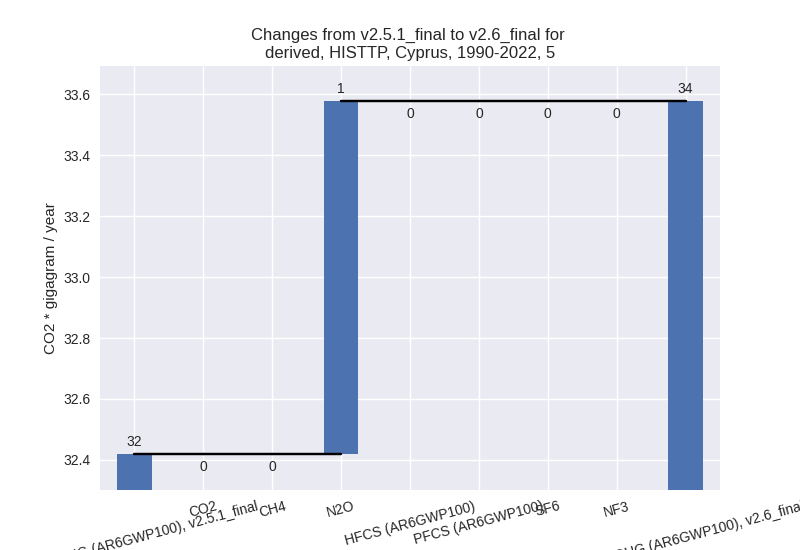Changes in PRIMAP-hist v2.6_final compared to v2.5.1_final for Cyprus
2024-09-24
Johannes Gütschow
Change analysis for Cyprus for PRIMAP-hist v2.6_final compared to v2.5.1_final
Overview over emissions by sector and gas
The following figures show the aggregate national total emissions excluding LULUCF AR6GWP100 for the country reported priority scenario. The dotted linesshow the v2.5.1_final data.
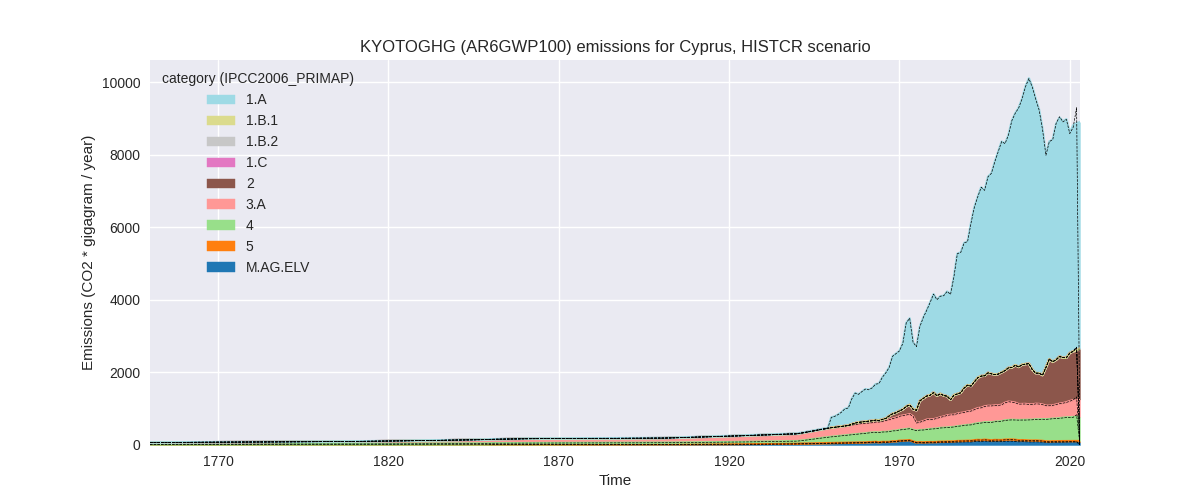
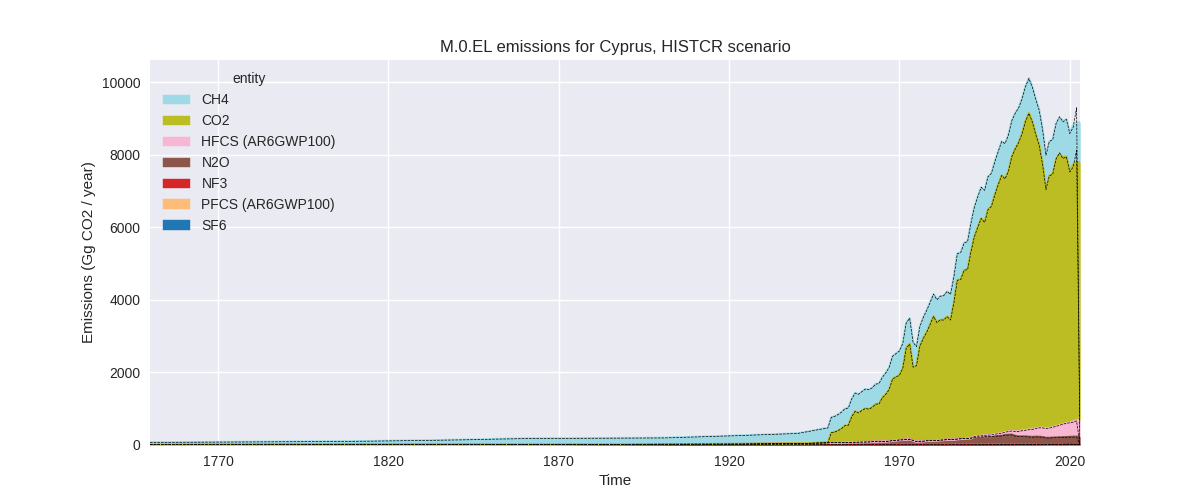
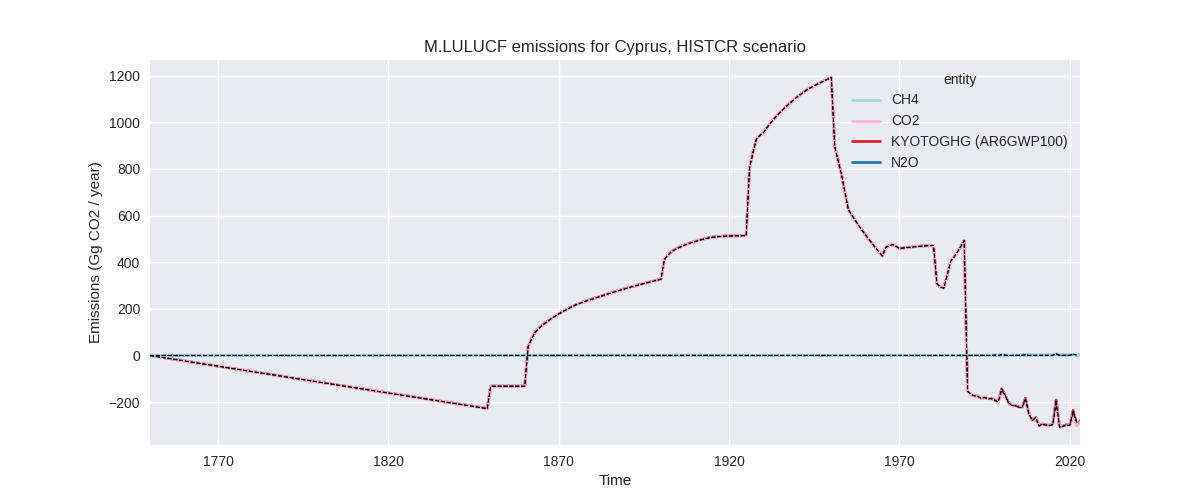
The following figures show the aggregate national total emissions excluding LULUCF AR6GWP100 for the third party priority scenario. The dotted linesshow the v2.5.1_final data.
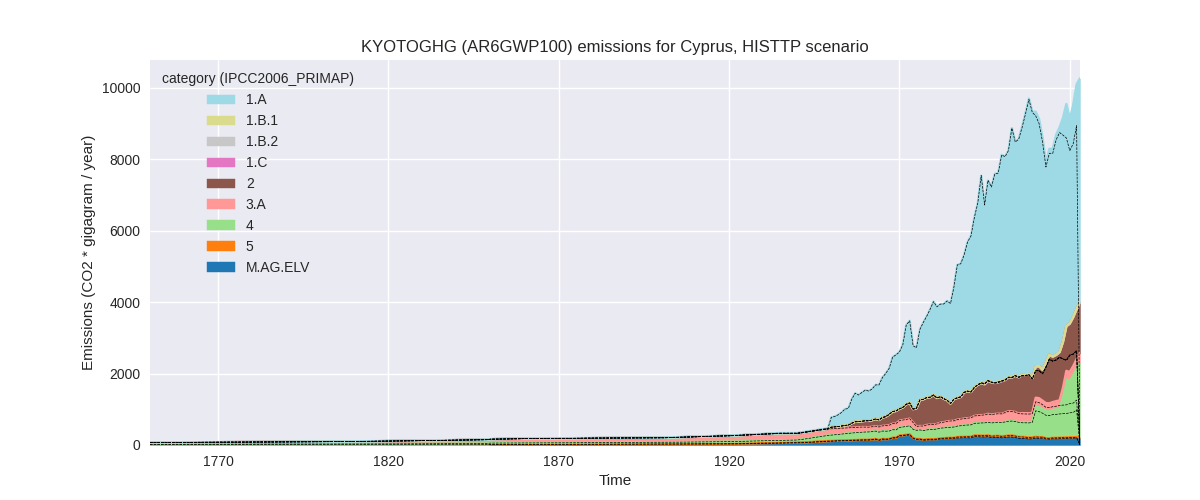
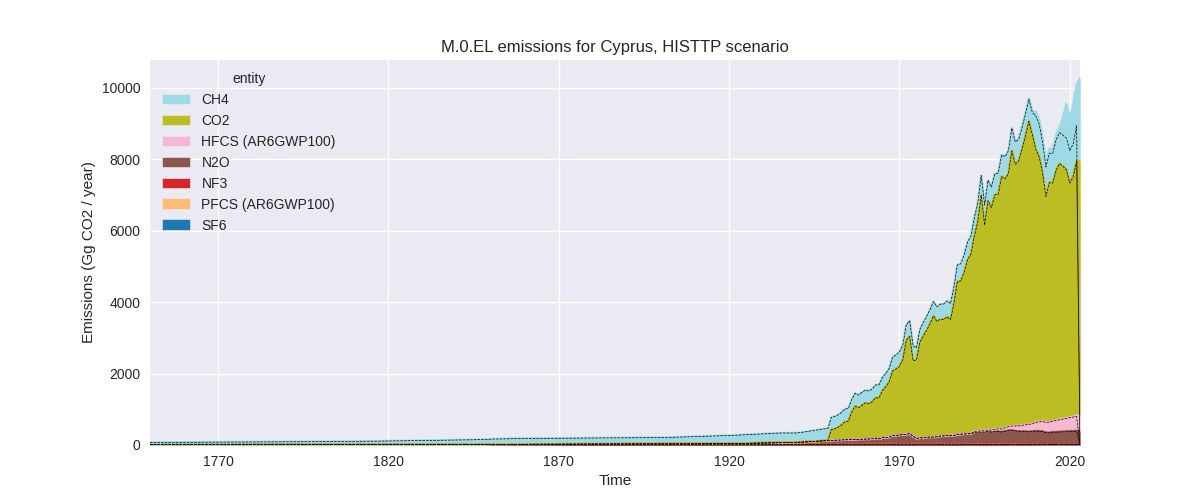
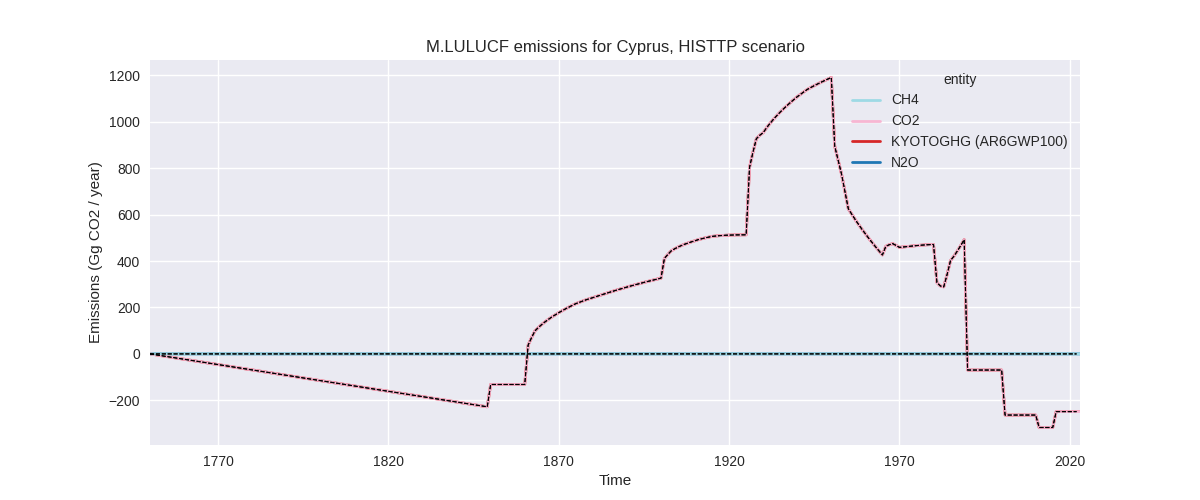
Overview over changes
In the country reported priority scenario we have the following changes for aggregate Kyoto GHG and national total emissions excluding LULUCF (M.0.EL):
- Emissions in 2022 have changed by -4.6%% (-426.77 Gg CO2 / year)
- Emissions in 1990-2022 have changed by -0.1%% (-10.93 Gg CO2 / year)
In the third party priority scenario we have the following changes for aggregate Kyoto GHG and national total emissions excluding LULUCF (M.0.EL):
- Emissions in 2022 have changed by 12.9%% (1152.55 Gg CO2 / year)
- Emissions in 1990-2022 have changed by 2.1%% (170.03 Gg CO2 / year)
Most important changes per scenario and time frame
In the country reported priority scenario the following sector-gas combinations have the highest absolute impact on national total KyotoGHG (AR6GWP100) emissions in 2022 (top 5):
- 1: 1.A, CO2 with -340.01 Gg CO2 / year (-5.2%)
- 2: 4, CH4 with -63.81 Gg CO2 / year (-9.1%)
- 3: 3.A, CH4 with -38.51 Gg CO2 / year (-8.6%)
- 4: 2, HFCS (AR6GWP100) with 7.49 Gg CO2 / year (1.7%)
- 5: 5, N2O with 5.71 Gg CO2 / year (28.9%)
In the country reported priority scenario the following sector-gas combinations have the highest absolute impact on national total KyotoGHG (AR6GWP100) emissions in 1990-2022 (top 5):
- 1: 1.A, CO2 with -8.07 Gg CO2 / year (-0.1%)
- 2: 4, CH4 with -2.31 Gg CO2 / year (-0.4%)
- 3: 3.A, CH4 with -1.55 Gg CO2 / year (-0.4%)
- 4: 5, N2O with 1.16 Gg CO2 / year (3.6%)
- 5: 2, HFCS (AR6GWP100) with -1.11 Gg CO2 / year (-0.6%)
In the third party priority scenario the following sector-gas combinations have the highest absolute impact on national total KyotoGHG (AR6GWP100) emissions in 2022 (top 5):
- 1: 4, CH4 with 1131.66 Gg CO2 / year (150.9%)
- 2: 2, HFCS (AR6GWP100) with 14.16 Gg CO2 / year (3.4%)
- 3: 5, N2O with 5.71 Gg CO2 / year (28.9%)
- 4: 1.A, CO2 with -5.17 Gg CO2 / year (-0.1%)
- 5: 4, N2O with 4.35 Gg CO2 / year (21.1%)
In the third party priority scenario the following sector-gas combinations have the highest absolute impact on national total KyotoGHG (AR6GWP100) emissions in 1990-2022 (top 5):
- 1: 4, CH4 with 166.62 Gg CO2 / year (34.5%)
- 2: 4, N2O with 1.22 Gg CO2 / year (7.7%)
- 3: 1.A, CO2 with 1.18 Gg CO2 / year (0.0%)
- 4: 5, N2O with 1.16 Gg CO2 / year (3.6%)
- 5: 2, CO2 with -1.02 Gg CO2 / year (-0.1%)
Notes on data changes
Here we list notes explaining important emissions changes for the country. ’' means that the following text only applies to the TP time series, while means that it only applies to the CR scenario. Otherwise the note applies to both scenarios.
- The 2024 EEA inventory has been included.
- The main 2022 changes come from lower 2021 - 2022 growth rates in EEA 2024 compared to CRF 2023 and EI 2023.
- For f-gases it is the difference between numerical extrapolation and EEA 2024.
- Changes in sectors 4 and 5 are due to the removal of FAOSTAT data.
Changes by sector and gas
For each scenario and time frame the changes are displayed for all individual sectors and all individual gases. In the sector plot we use aggregate Kyoto GHGs in AR6GWP100. In the gas plot we usenational total emissions without LULUCF. ## country reported scenario
2022
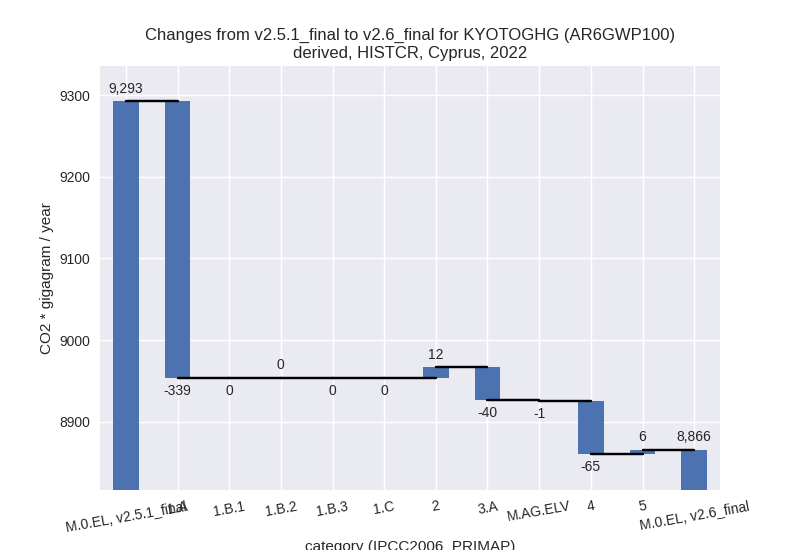
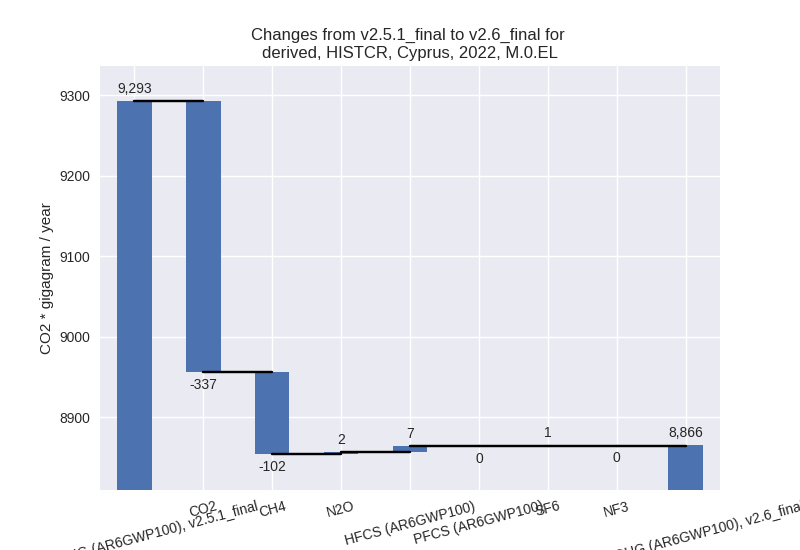
1990-2022
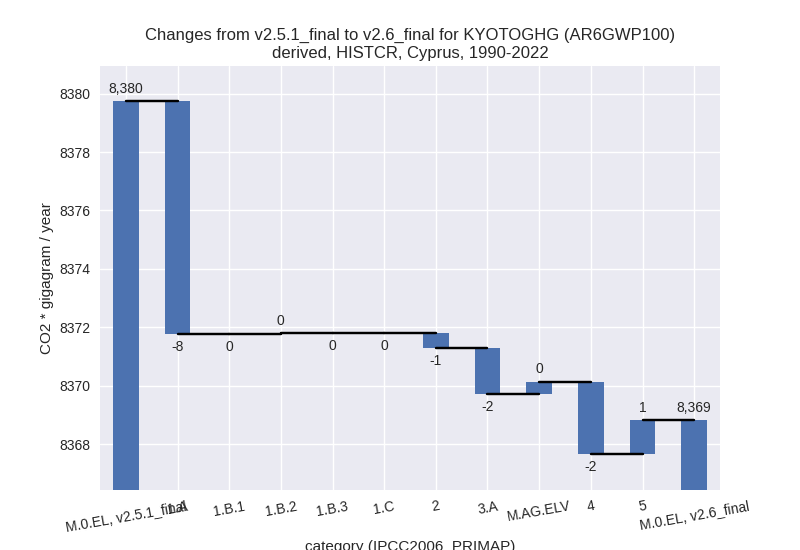
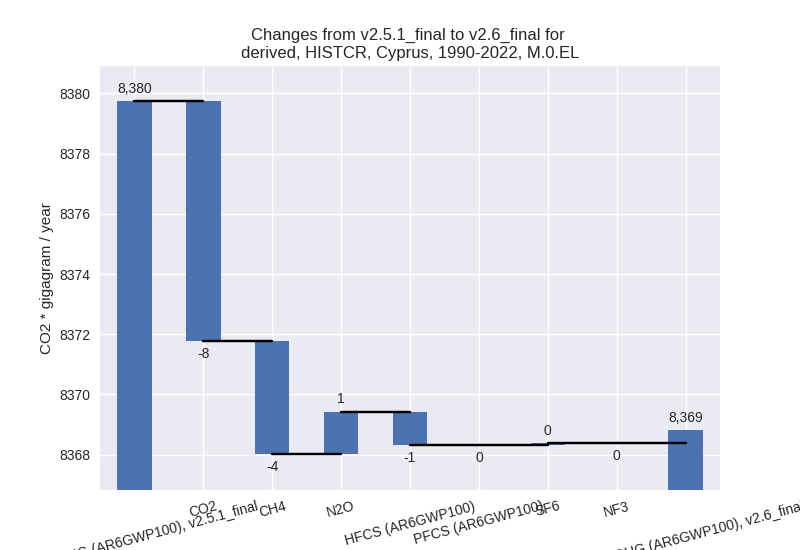
third party scenario
2022
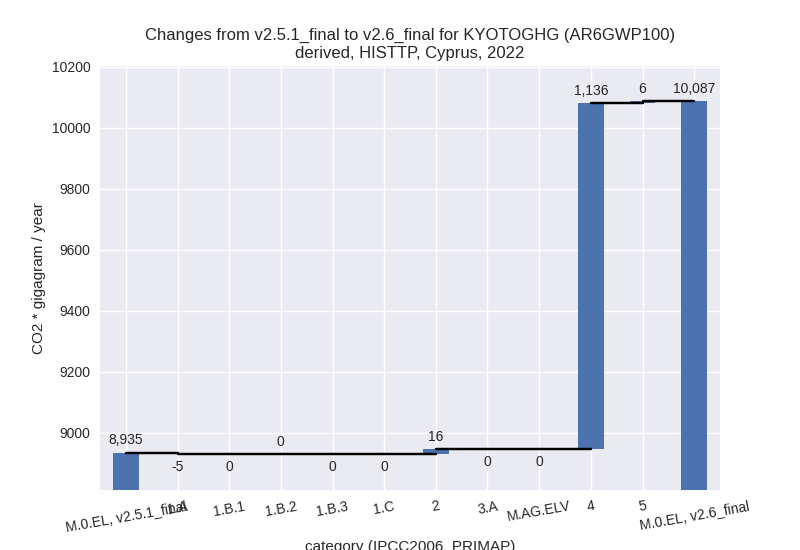

1990-2022
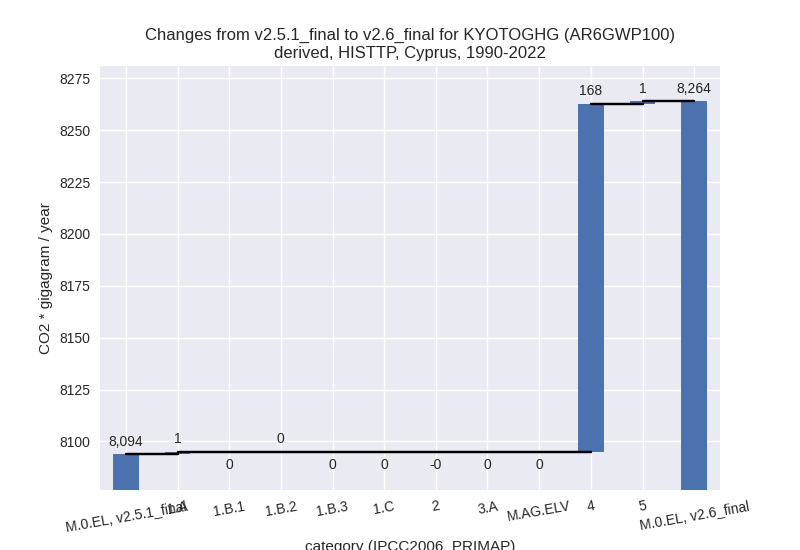
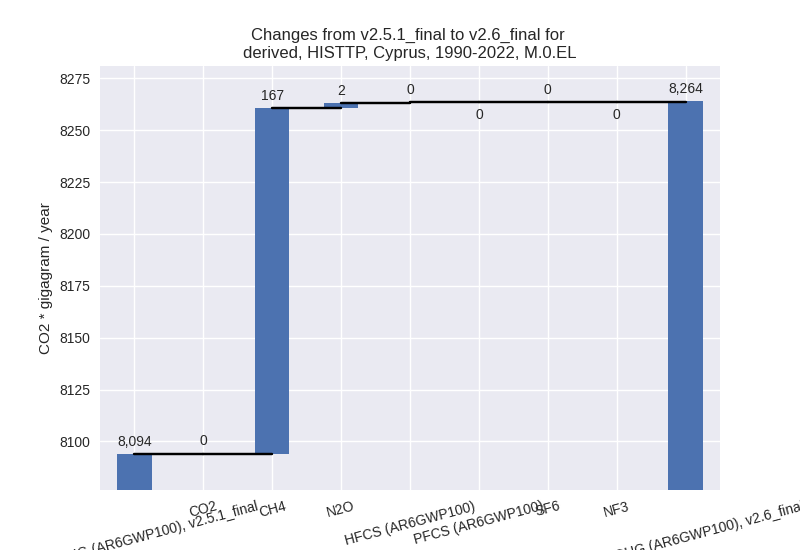
Detailed changes for the scenarios:
country reported scenario (HISTCR):
Most important changes per time frame
For 2022 the following sector-gas combinations have the highest absolute impact on national total KyotoGHG (AR6GWP100) emissions in 2022 (top 5):
- 1: 1.A, CO2 with -340.01 Gg CO2 / year (-5.2%)
- 2: 4, CH4 with -63.81 Gg CO2 / year (-9.1%)
- 3: 3.A, CH4 with -38.51 Gg CO2 / year (-8.6%)
- 4: 2, HFCS (AR6GWP100) with 7.49 Gg CO2 / year (1.7%)
- 5: 5, N2O with 5.71 Gg CO2 / year (28.9%)
For 1990-2022 the following sector-gas combinations have the highest absolute impact on national total KyotoGHG (AR6GWP100) emissions in 1990-2022 (top 5):
- 1: 1.A, CO2 with -8.07 Gg CO2 / year (-0.1%)
- 2: 4, CH4 with -2.31 Gg CO2 / year (-0.4%)
- 3: 3.A, CH4 with -1.55 Gg CO2 / year (-0.4%)
- 4: 5, N2O with 1.16 Gg CO2 / year (3.6%)
- 5: 2, HFCS (AR6GWP100) with -1.11 Gg CO2 / year (-0.6%)
Changes in the main sectors for aggregate KyotoGHG (AR6GWP100) are
- 1: Total sectoral emissions in 2022 are 6260.75 Gg
CO2 / year which is 70.6% of M.0.EL emissions. 2022 Emissions have
changed by -5.1% (-338.64 Gg CO2 /
year). 1990-2022 Emissions have changed by -0.1% (-7.94 Gg CO2 / year). For 2022 the
changes per gas
are:
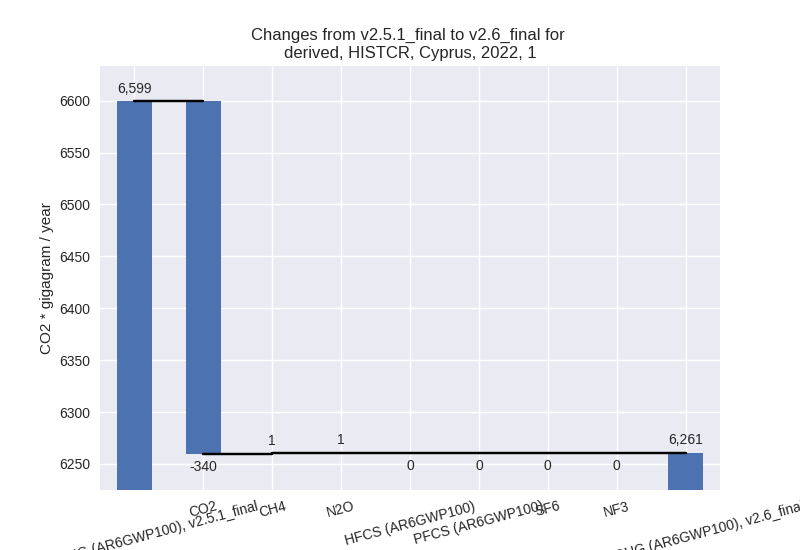
The changes come from the following subsectors:- 1.A: Total sectoral emissions in 2022 are 6260.74
Gg CO2 / year which is 100.0% of category 1 emissions. 2022 Emissions
have changed by -5.1% (-338.64 Gg
CO2 / year). 1990-2022 Emissions have changed by -0.1% (-7.98 Gg CO2 / year). For 2022 the
changes per gas
are:
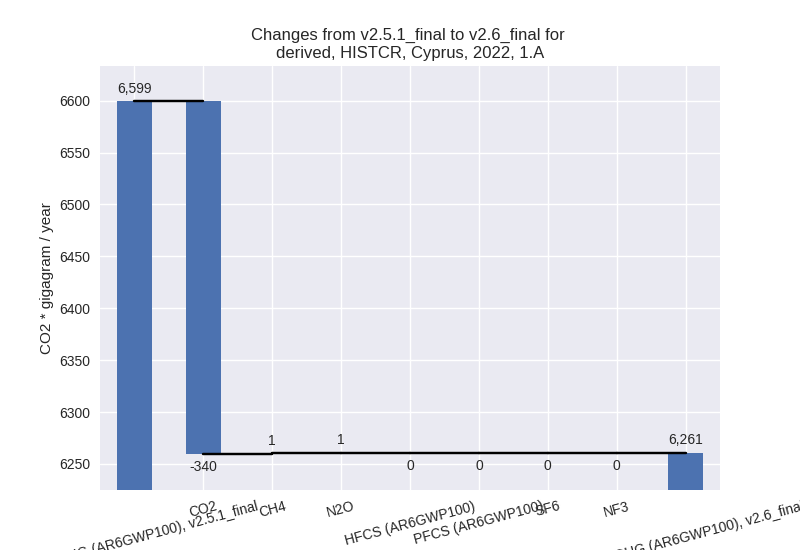
There is no subsector information available in PRIMAP-hist. - 1.B.2: Total sectoral emissions in 2022 are 0.00 Gg
CO2 / year which is 0.0% of category 1 emissions. 2022 Emissions have
changed by inf% (0.00 Gg CO2 /
year). 1990-2022 Emissions have changed by 13.0% (0.04 Gg CO2 / year). For 2022 the
changes per gas
are:
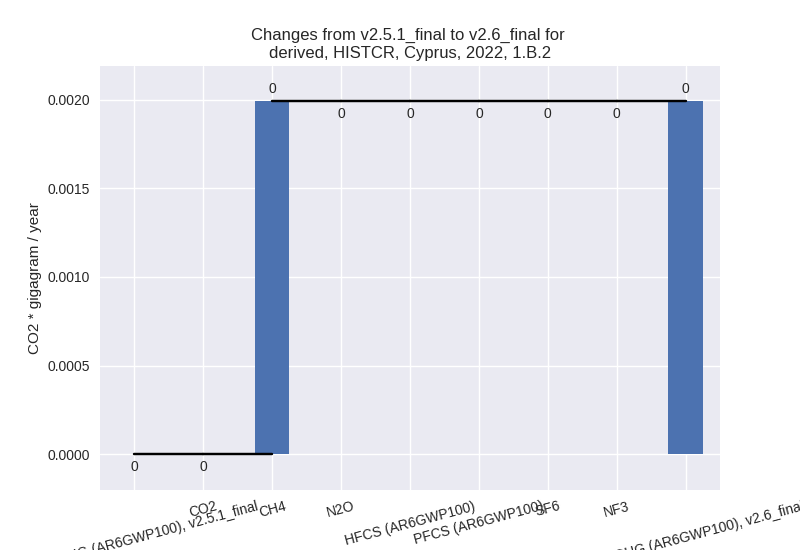
For 1990-2022 the changes per gas are: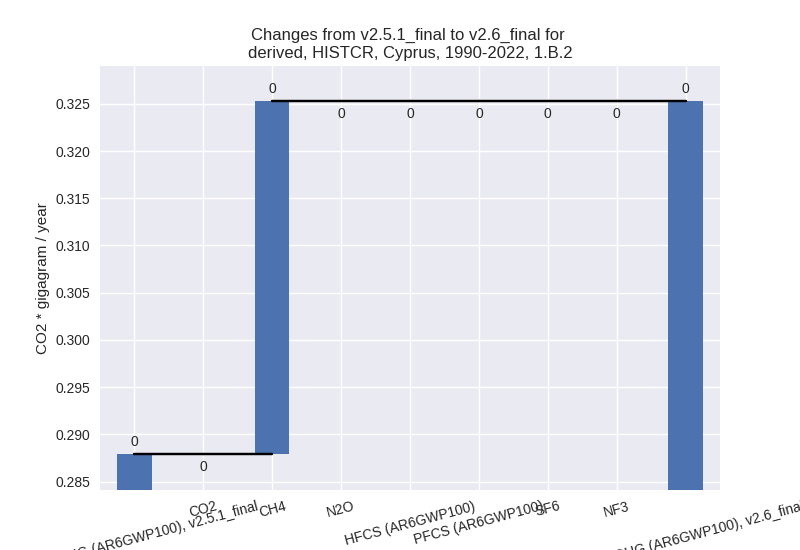
There is no subsector information available in PRIMAP-hist.
- 1.A: Total sectoral emissions in 2022 are 6260.74
Gg CO2 / year which is 100.0% of category 1 emissions. 2022 Emissions
have changed by -5.1% (-338.64 Gg
CO2 / year). 1990-2022 Emissions have changed by -0.1% (-7.98 Gg CO2 / year). For 2022 the
changes per gas
are:
- 2: Total sectoral emissions in 2022 are 1380.04 Gg CO2 / year which is 15.6% of M.0.EL emissions. 2022 Emissions have changed by 0.9% (12.43 Gg CO2 / year). 1990-2022 Emissions have changed by -0.1% (-0.51 Gg CO2 / year).
- M.AG: Total sectoral emissions in 2022 are 535.81
Gg CO2 / year which is 6.0% of M.0.EL emissions. 2022 Emissions have
changed by -7.1% (-41.20 Gg CO2 /
year). 1990-2022 Emissions have changed by -0.2% (-1.14 Gg CO2 / year). For 2022 the
changes per gas
are:
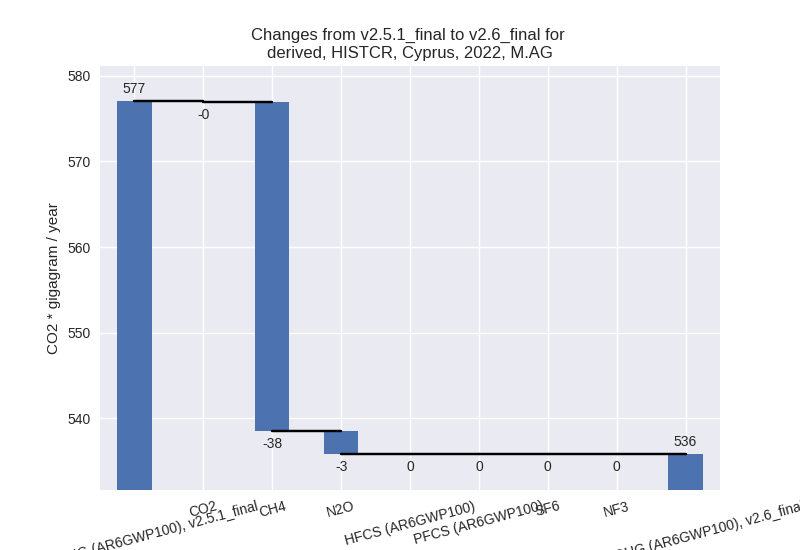
The changes come from the following subsectors:- 3.A: Total sectoral emissions in 2022 are 453.22 Gg
CO2 / year which is 84.6% of category M.AG emissions. 2022 Emissions
have changed by -8.1% (-40.02 Gg CO2
/ year). 1990-2022 Emissions have changed by -0.4% (-1.58 Gg CO2 / year). For 2022 the
changes per gas
are:
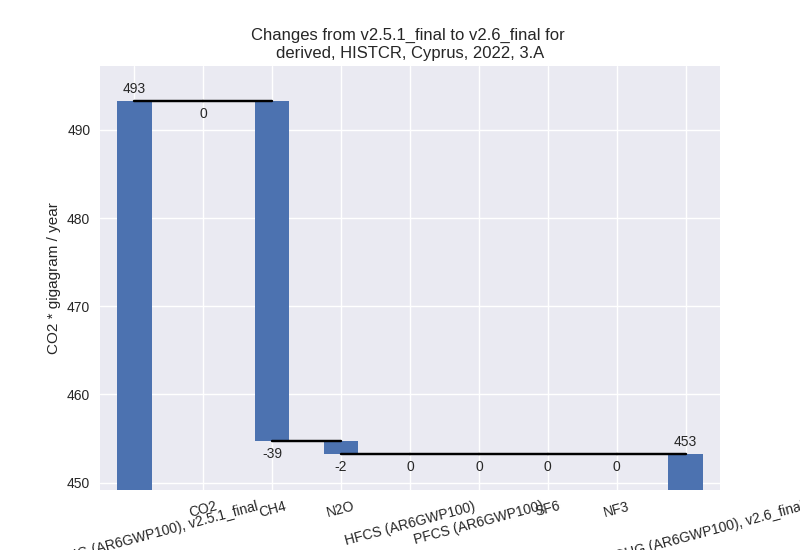
There is no subsector information available in PRIMAP-hist. - M.AG.ELV: Total sectoral emissions in 2022 are 82.60 Gg CO2 / year which is 15.4% of category M.AG emissions. 2022 Emissions have changed by -1.4% (-1.17 Gg CO2 / year). 1990-2022 Emissions have changed by 0.5% (0.44 Gg CO2 / year).
- 3.A: Total sectoral emissions in 2022 are 453.22 Gg
CO2 / year which is 84.6% of category M.AG emissions. 2022 Emissions
have changed by -8.1% (-40.02 Gg CO2
/ year). 1990-2022 Emissions have changed by -0.4% (-1.58 Gg CO2 / year). For 2022 the
changes per gas
are:
- 4: Total sectoral emissions in 2022 are 663.67 Gg
CO2 / year which is 7.5% of M.0.EL emissions. 2022 Emissions have
changed by -8.9% (-65.07 Gg CO2 /
year). 1990-2022 Emissions have changed by -0.4% (-2.49 Gg CO2 / year). For 2022 the
changes per gas
are:
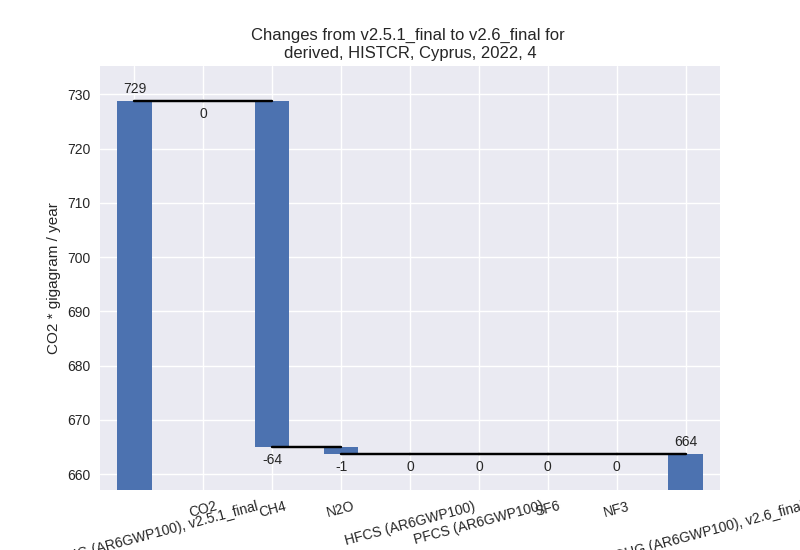
- 5: Total sectoral emissions in 2022 are 25.49 Gg
CO2 / year which is 0.3% of M.0.EL emissions. 2022 Emissions have
changed by 28.9% (5.71 Gg CO2 /
year). 1990-2022 Emissions have changed by 3.6% (1.16 Gg CO2 / year). For 2022 the
changes per gas
are:
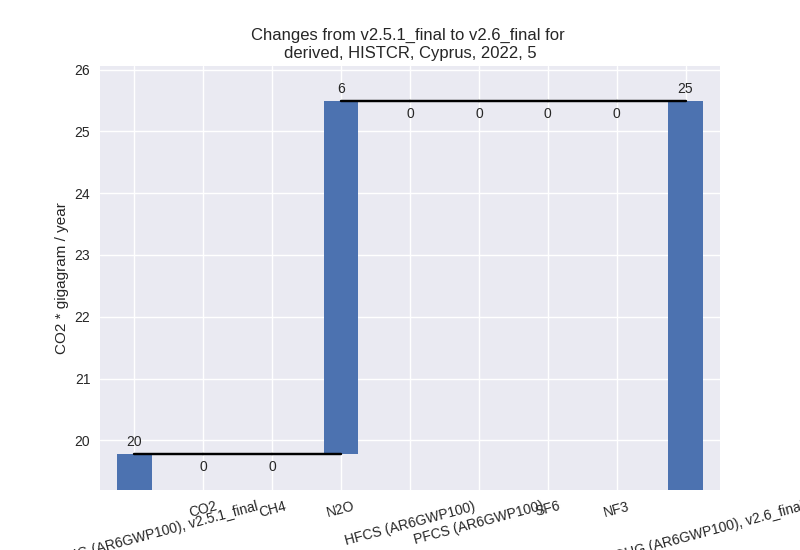
For 1990-2022 the changes per gas are: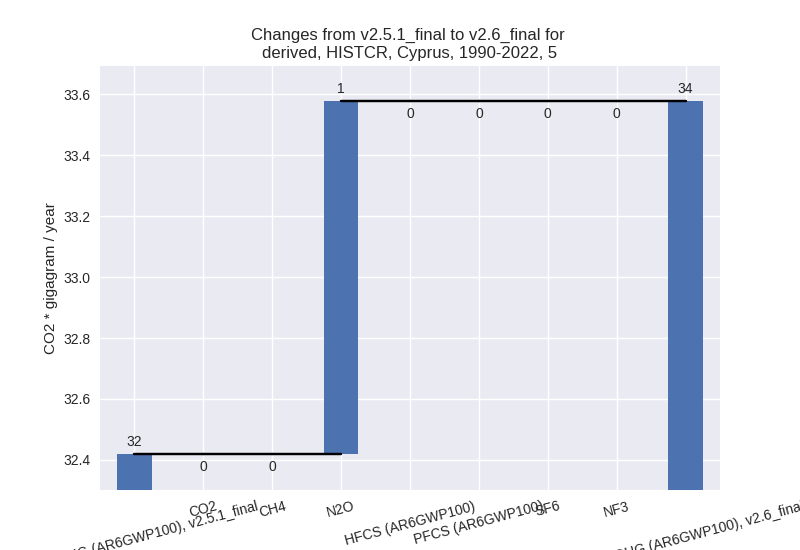
third party scenario (HISTTP):
Most important changes per time frame
For 2022 the following sector-gas combinations have the highest absolute impact on national total KyotoGHG (AR6GWP100) emissions in 2022 (top 5):
- 1: 4, CH4 with 1131.66 Gg CO2 / year (150.9%)
- 2: 2, HFCS (AR6GWP100) with 14.16 Gg CO2 / year (3.4%)
- 3: 5, N2O with 5.71 Gg CO2 / year (28.9%)
- 4: 1.A, CO2 with -5.17 Gg CO2 / year (-0.1%)
- 5: 4, N2O with 4.35 Gg CO2 / year (21.1%)
For 1990-2022 the following sector-gas combinations have the highest absolute impact on national total KyotoGHG (AR6GWP100) emissions in 1990-2022 (top 5):
- 1: 4, CH4 with 166.62 Gg CO2 / year (34.5%)
- 2: 4, N2O with 1.22 Gg CO2 / year (7.7%)
- 3: 1.A, CO2 with 1.18 Gg CO2 / year (0.0%)
- 4: 5, N2O with 1.16 Gg CO2 / year (3.6%)
- 5: 2, CO2 with -1.02 Gg CO2 / year (-0.1%)
Changes in the main sectors for aggregate KyotoGHG (AR6GWP100) are
- 1: Total sectoral emissions in 2022 are 6289.33 Gg CO2 / year which is 62.4% of M.0.EL emissions. 2022 Emissions have changed by -0.1% (-5.16 Gg CO2 / year). 1990-2022 Emissions have changed by 0.0% (1.19 Gg CO2 / year).
- 2: Total sectoral emissions in 2022 are 1399.19 Gg CO2 / year which is 13.9% of M.0.EL emissions. 2022 Emissions have changed by 1.2% (15.99 Gg CO2 / year). 1990-2022 Emissions have changed by -0.0% (-0.15 Gg CO2 / year).
- M.AG: Total sectoral emissions in 2022 are 466.58 Gg CO2 / year which is 4.6% of M.0.EL emissions. 2022 Emissions have changed by 0.0% (0.00 Gg CO2 / year). 1990-2022 Emissions have changed by 0.0% (0.00 Gg CO2 / year).
- 4: Total sectoral emissions in 2022 are 1906.51 Gg
CO2 / year which is 18.9% of M.0.EL emissions. 2022 Emissions have
changed by 147.4% (1136.01 Gg CO2 /
year). 1990-2022 Emissions have changed by 33.6% (167.83 Gg CO2 / year). For 2022 the
changes per gas
are:
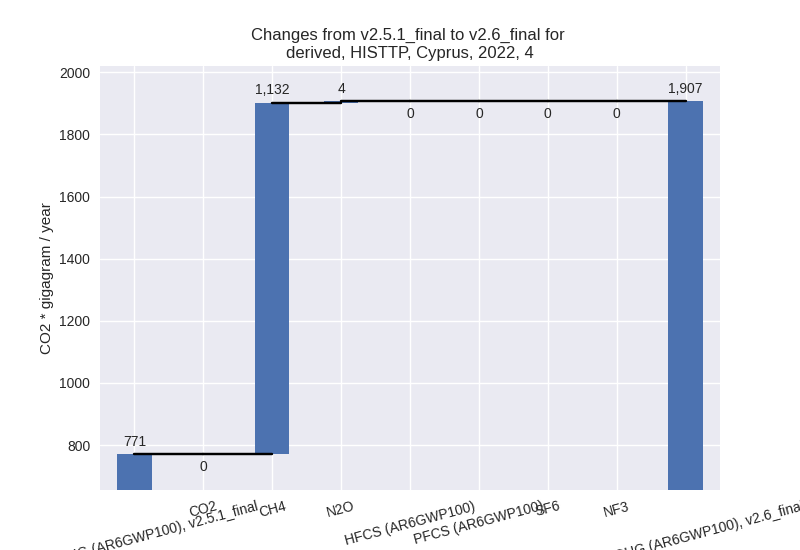
For 1990-2022 the changes per gas are: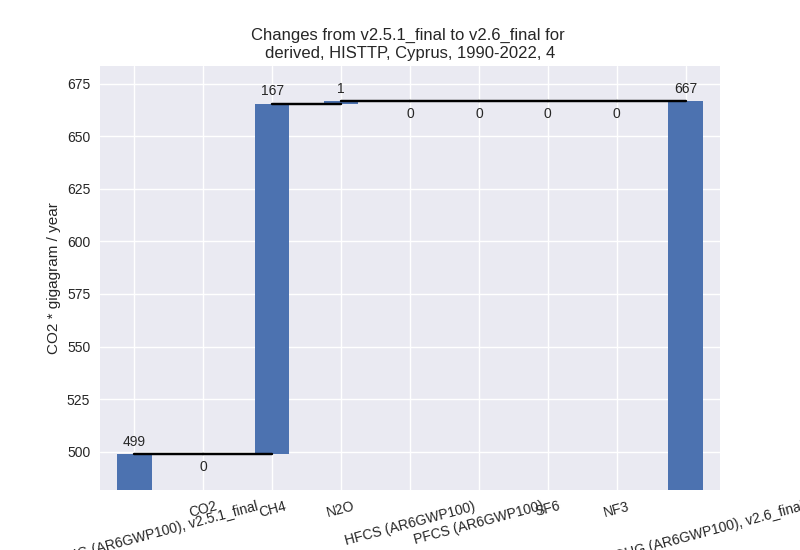
- 5: Total sectoral emissions in 2022 are 25.49 Gg
CO2 / year which is 0.3% of M.0.EL emissions. 2022 Emissions have
changed by 28.9% (5.71 Gg CO2 /
year). 1990-2022 Emissions have changed by 3.6% (1.16 Gg CO2 / year). For 2022 the
changes per gas
are:
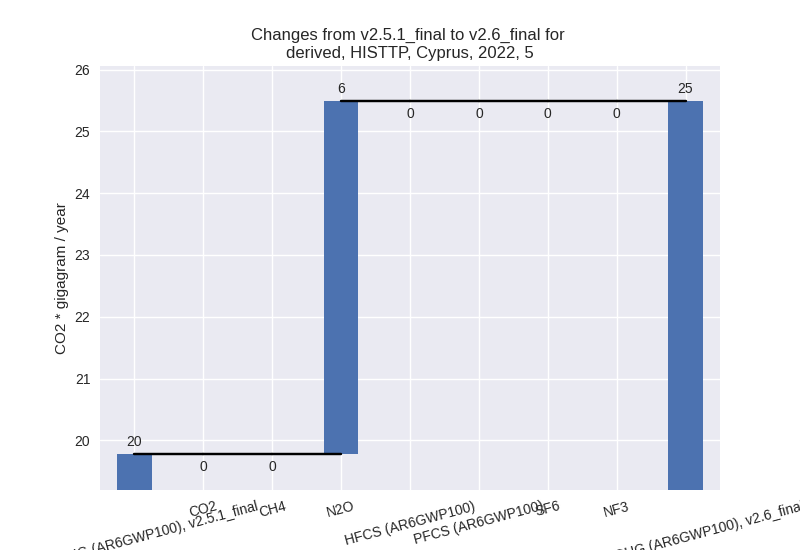
For 1990-2022 the changes per gas are: